Why Consumers Pay More for Driverless Rides?
This analysis examines the surprising 60% price premium for Waymo's driverless rides compared to Uber and Lyft in Phoenix, with data from identical routes at different times of day. The post explores multiple explanations including supply-demand imbalance, novelty factor, strategic luxury positioning, and the socioeconomic implications of this emerging technology.

The Premium Paradox - Why Consumers Pay More for Driverless Rides
In theory, autonomous vehicles should make ridesharing cheaper by eliminating driver costs. Yet, surprisingly, companies like Waymo are charging premium prices for their driverless services based on my experience in Phoenix and Tempe. After analyzing several rideshare options for the same route between downtown Phoenix (300/302 W Monroe St) and Tempe Marketplace, I’ve discovered a striking price differential that raises important questions about consumer behavior and the economics of emerging technology.
The Price Gap: Analyzing Waymo vs. Traditional Rideshares
Morning
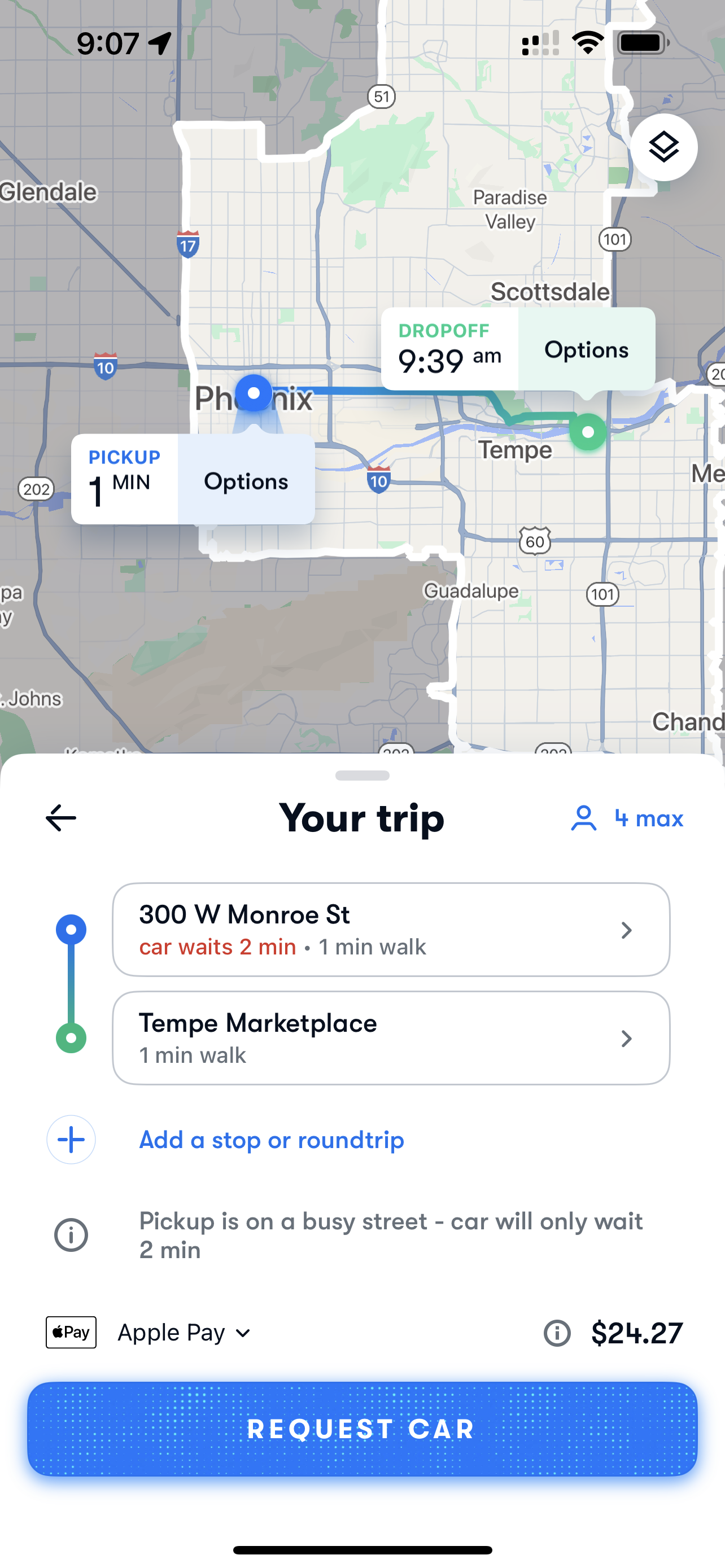
Waymo
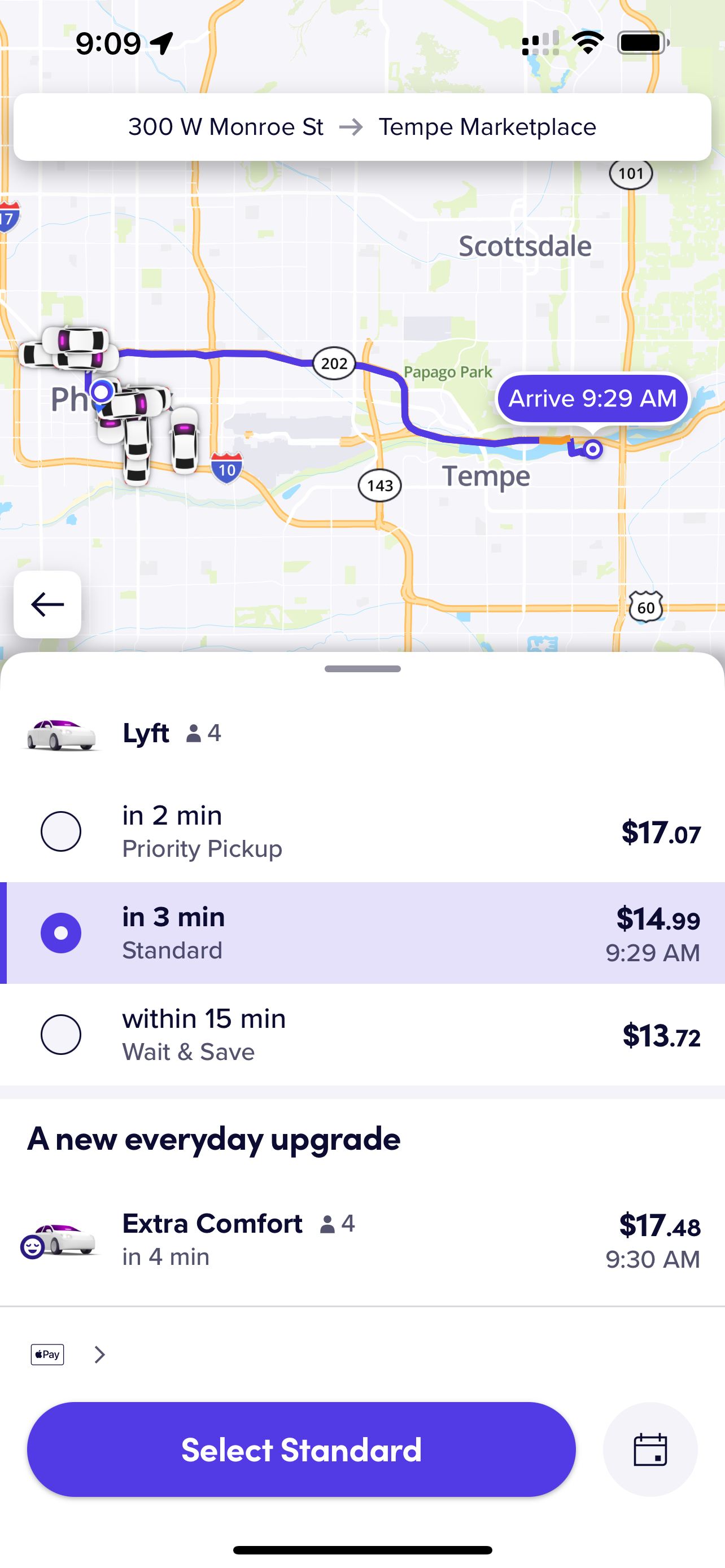
Lyft
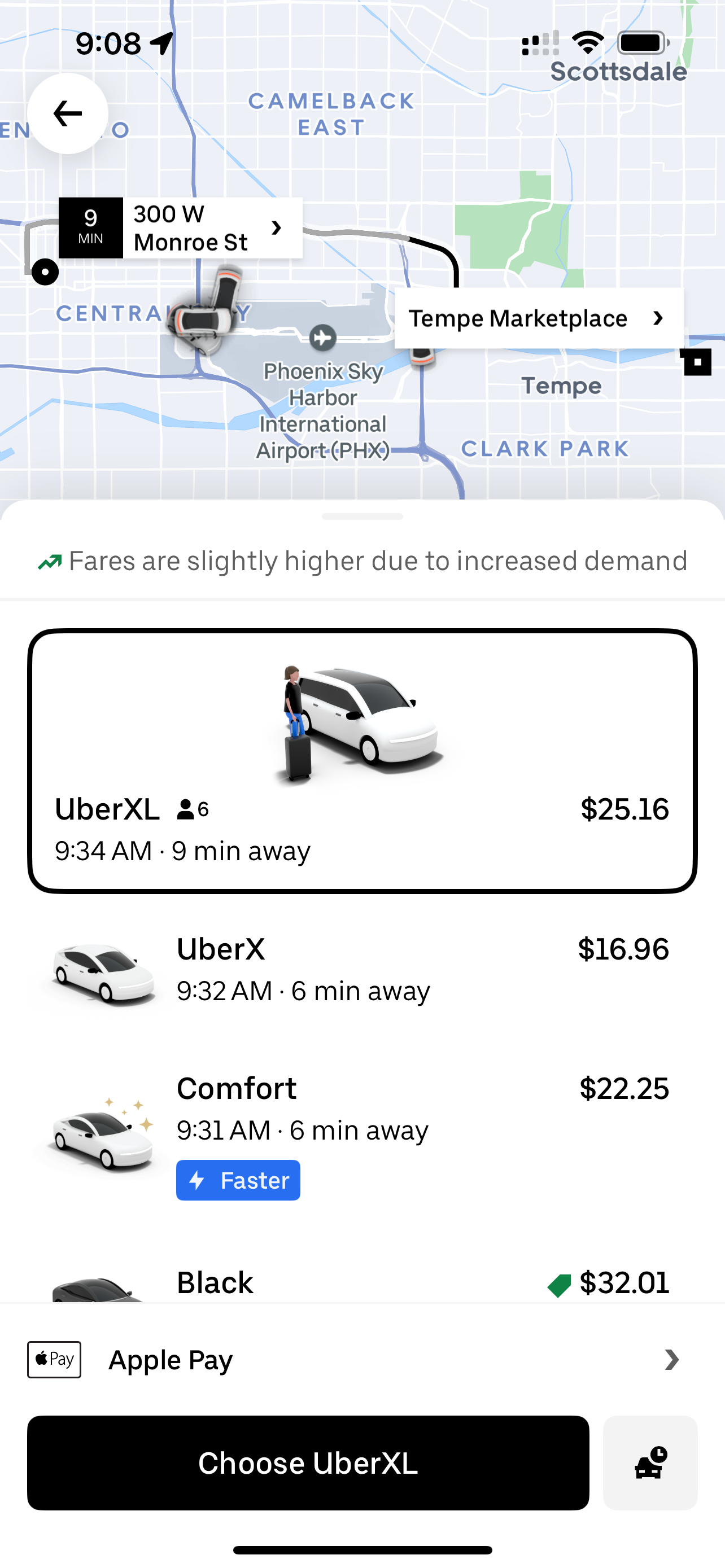
Uber
Evening
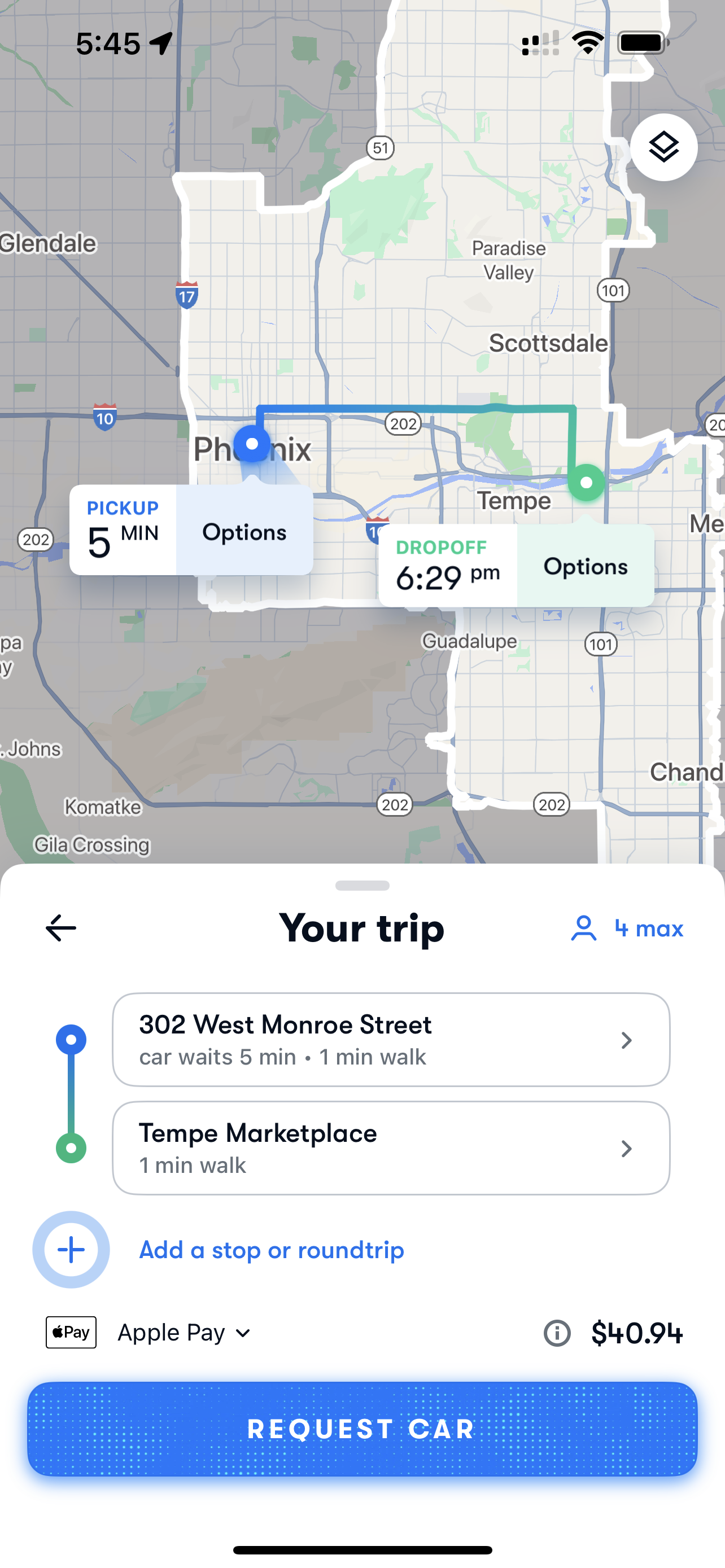
Waymo
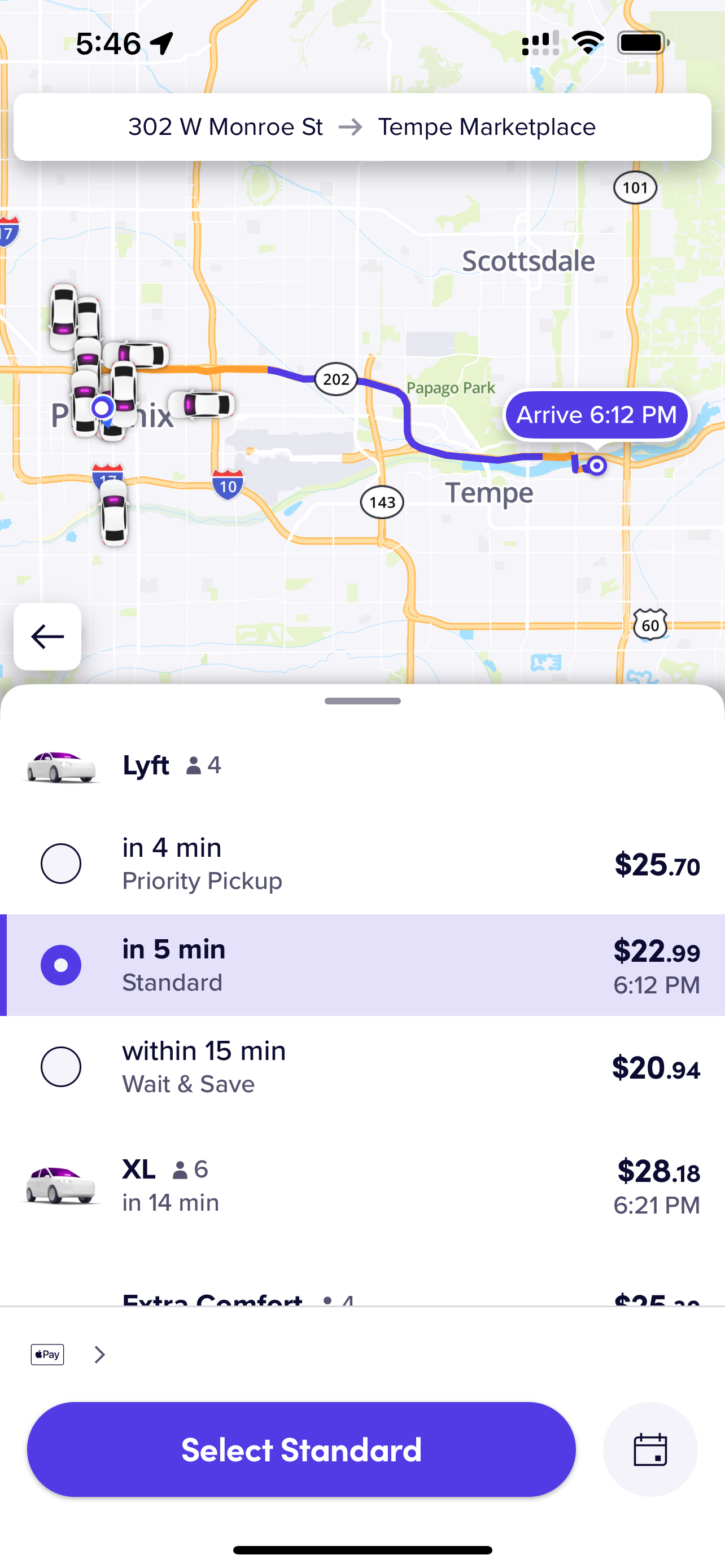
Lyft
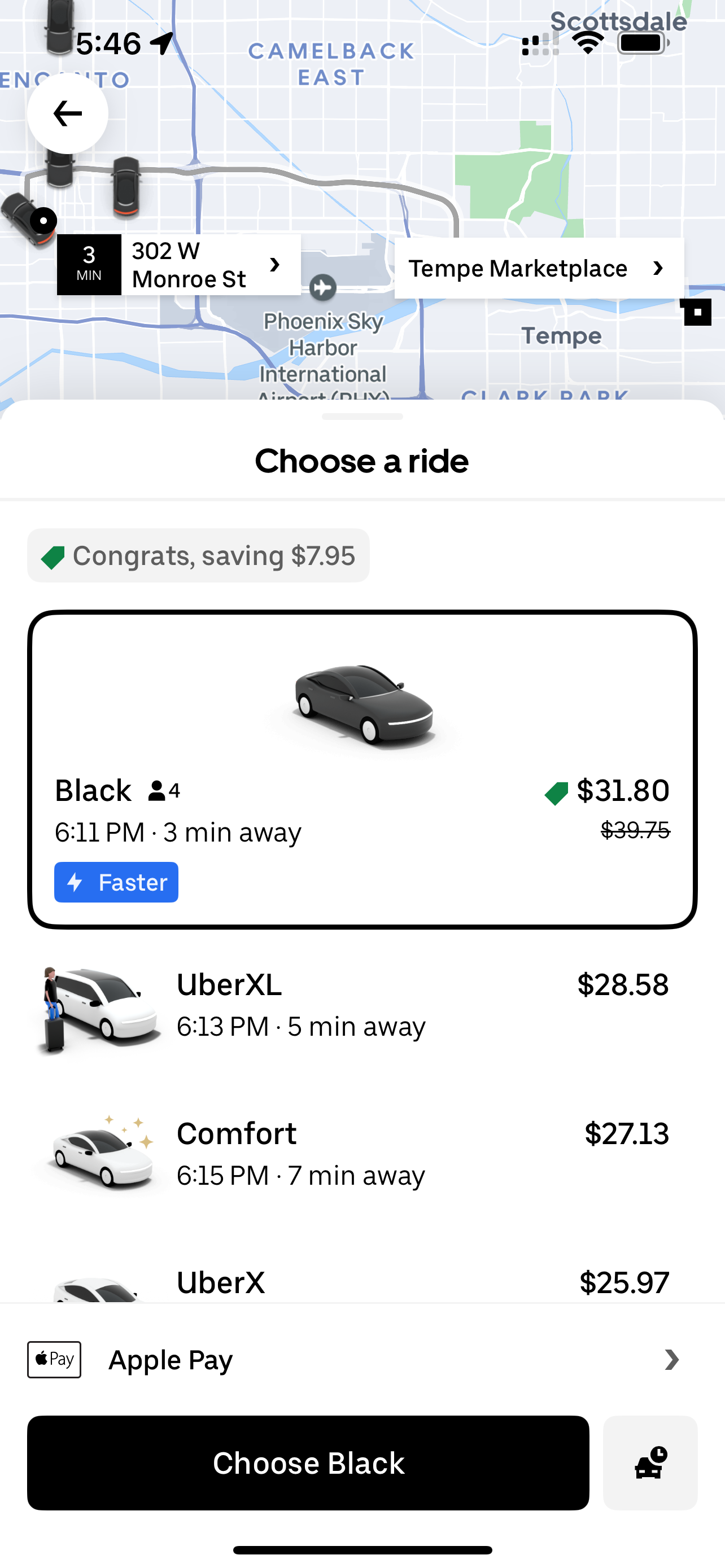
Uber
Looking at identical routes during morning and evening timeframes, I’ve compiled the following data:
| Time | Service | Option | Arrival Time | Price | Wait Time |
|---|---|---|---|---|---|
| Morning (9AM) | Lyft | Standard | 9:29 AM | $14.99 | 3 min |
| Morning (9AM) | Lyft | Priority | 9:29 AM | $17.07 | 2 min |
| Morning (9AM) | Lyft | Wait & Save | 9:29 AM | $13.72 | 15 min |
| Morning (9AM) | Lyft | Extra Comfort | 9:30 AM | $17.48 | 4 min |
| Morning (9AM) | Uber | UberX | 9:32 AM | $16.96 | 6 min |
| Morning (9AM) | Uber | UberXL | 9:34 AM | $25.16 | 9 min |
| Morning (9AM) | Uber | Comfort | 9:31 AM | $22.25 | 6 min |
| Morning (9AM) | Uber | Black | Not shown | $32.01 | Not shown |
| Morning (9AM) | Waymo | Standard | 9:39 AM | $24.27 | 1 min |
| Evening (5:45PM) | Lyft | Standard | 6:12 PM | $22.99 | 5 min |
| Evening (5:45PM) | Lyft | Priority | 6:12 PM | $25.70 | 4 min |
| Evening (5:45PM) | Lyft | Wait & Save | 6:12 PM | $20.94 | 15 min |
| Evening (5:45PM) | Lyft | XL | 6:21 PM | $28.18 | 14 min |
| Evening (5:45PM) | Uber | UberX | Not shown | $25.97 | Not shown |
| Evening (5:45PM) | Uber | UberXL | 6:13 PM | $28.58 | 5 min |
| Evening (5:45PM) | Uber | Comfort | 6:15 PM | $27.13 | 7 min |
| Evening (5:45PM) | Uber | Black | 6:11 PM | $31.80 | 3 min |
| Evening (5:45PM) | Waymo | Standard | 6:29 PM | $40.94 | 5 min |
Key Findings:
- Morning Premium: Waymo charges $24.27 for the morning ride, which is:
- 62% more than Lyft Standard ($14.99)
- 43% more than UberX ($16.96)
- 39% more than Lyft Priority Pickup ($17.07)
- Evening Premium: Waymo’s evening price of $40.94 is:
- 78% more than Lyft Standard ($22.99)
- 58% more than UberX ($25.97)
- 59% more than Lyft Priority Pickup ($25.70)
- 29% more than Uber Black ($31.80), typically considered the premium option
- Average Premium: Across both time periods, Waymo charges approximately 60% more than comparable standard rideshare options.
Why Would Consumers Pay More for Driverless Technology?
The significant price premium for Waymo rides challenges the conventional wisdom that removing human labor should reduce costs. Several factors might explain this paradox:
1. The Novelty Factor: Technology as Luxury Experience
When the iPhone first launched, consumers willingly paid premium prices for revolutionary technology. Similarly, riding in a fully autonomous vehicle remains a novel experience for most people. This novelty creates perceived value beyond mere transportation.
The experience in a Waymo vehicle isn’t just about getting from point A to point B—it’s about participating in what feels like the future. The sophisticated interior, customizable music, climate control, and the sheer wonder of watching a car drive itself create an experience more akin to entertainment than utilitarian transportation.
2. Early Adoption and Status Signaling
Behavioral economics suggests that early adopters gain social capital by experiencing new technologies before others. Paying more for a Waymo ride might serve as a form of status signaling—demonstrating one’s openness to innovation, technological savviness, and financial ability to access cutting-edge experiences.
3. The Apple Strategy: Luxury Positioning in Technology
Is Waymo following Apple’s strategic playbook—positioning autonomous ridesharing as a premium product rather than competing on price? By establishing itself in the luxury segment first, Waymo can build brand equity that may be difficult for future competitors to challenge.
This strategy allows Waymo to recoup massive R&D investments while establishing customer relationships with less price-sensitive early adopters. As technology costs decrease and operations scale, Waymo could potentially introduce more affordable options while maintaining premium offerings.
4. The Supply-Demand Imbalance
A more straightforward explanation for Waymo’s premium pricing may be the basic economic principle of supply and demand. Waymo is still in its expansion phase, with a limited fleet of vehicles operating in select markets like Phoenix/Tempe. This creates a natural scarcity that allows the company to charge higher prices and creates several effects:
- Operational constraints: With fewer vehicles, Waymo must charge more per ride to cover fixed costs like maintenance facilities, engineering support, and software infrastructure
- Demand-based pricing: Higher prices help manage demand to match the limited supply of vehicles
- Testing price elasticity: Waymo may be deliberately testing different price points to determine how much consumers are willing to pay for autonomous rides
- Recovering R&D costs: The current higher pricing helps recoup the massive investment in developing the technology
As Waymo scales its operations and deploys more vehicles, these supply constraints should naturally ease. The question remains whether prices will drop accordingly or if Waymo will maintain premium positioning.
The Socioeconomic Implications
Beyond consumer psychology, the premium pricing of autonomous vehicles raises important questions about technology’s impact on economic equality:
Winners and Losers in the Autonomous Economy
Who’s losing? The most obvious impact falls on professional drivers whose livelihoods depend on rideshare platforms. While the transition to autonomy will likely be gradual, it represents a significant displacement of middle-skill jobs that have provided economic opportunities for many.
Who’s winning? The economic benefits flow primarily to:
- Engineers and technical specialists developing the technology
- Shareholders of companies like Waymo and Jaguar
- Corporate executives guiding these companies
- Consumers with sufficient disposable income to access the technology
This redistribution of economic benefits risks exacerbating income inequality, as the financial returns from automation increasingly flow to those with capital and advanced technical skills.
Short-term Fad or Long-term Trend?
Is consumer willingness to pay such premiums sustainable, or merely a temporary phenomenon driven by novelty and supply constraints? History suggests the premium may erode as:
- Fleet size increases: As Waymo deploys more vehicles, the supply-demand balance will shift
- Competition increases: As more companies enter the autonomous rideshare market, price competition will likely intensify
- Technology costs decrease: The sensors, computing systems, and other components will become less expensive with scale
- Novelty fades: As autonomous vehicles become commonplace, their experiential value may diminish
However, if Waymo successfully establishes itself as the “Apple of autonomous transportation,” it may maintain premium pricing through brand value, superior user experience, and perceived safety advantages even after supply constraints ease.
Conclusion
In my humble opinion, the current premium pricing of Waymo likely represents a transitional phase rather than the end state of autonomous transportation. As the technology matures, we might expect several developments:
-
Tiered service models: Companies may offer various autonomous vehicle experiences at different price points, similar to how airlines offer economy, premium economy, business, and first-class options
-
Subscription services: Monthly or annual memberships providing unlimited or discounted autonomous rides, creating predictable revenue streams and customer loyalty
-
Integration with public transit: Partnerships between autonomous vehicle companies and public transportation systems, potentially subsidized to ensure broader accessibility
-
New ownership models: Fractional ownership or time-sharing arrangements for autonomous vehicles, spreading costs across multiple users
The willingness of consumers to pay significant premiums for driverless technology demonstrates that transportation is evolving beyond mere utility into an experience category where factors beyond efficiency and cost determine value. This shift has profound implications for how we think about mobility, technology adoption, and the distribution of economic benefits in an increasingly automated world.
What’s your experience? Have you tried a driverless ride? Would you pay more for the experience, or do you expect autonomous technology to make transportation more affordable? Share your thoughts in the comments below.
